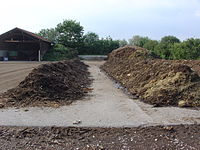
Photo from wikipedia
Nutrient pollution released from highly accumulated swine wastewater is getting concerned due to global warming and waterbody harmful. Traditional combination of nitrification and denitrification is commonly applied to remove carbon… Click to show full abstract
Nutrient pollution released from highly accumulated swine wastewater is getting concerned due to global warming and waterbody harmful. Traditional combination of nitrification and denitrification is commonly applied to remove carbon and nitrogen compounds resided in various wastewater with disadvantages of high cost and energy requirements. This study applied the thermophilic flat panel photobioreactor (tFPBR) with high growth rate of TCL-1 culture to evaluate the efficiency of inorganic carbon and nitrogen transformation. This 12-h operation resulted that TCL-1 enriched batch, grown in 50 °C and alkaline environment with 1,000 µE/m2/s light intensity, had high potential for CO2 fixation rate of 122.29 ± 9.93 mg/L/h and nitrogen removal rate of 7.76 mg-N/L/h treating swine wastewater, in comparison with comprehensive community involved in carbon and nitrogen cycles in the field-scale anoxic tank. This study provided the Rapid-growing photosynthetic cyanobacteria in place of slow-growing autotrophic microbes for of carbon and nitrogen transformation in the wastewater system.
Journal Title: Bioresource technology
Year Published: 2021
Link to full text (if available)
Share on Social Media: Sign Up to like & get
recommendations!